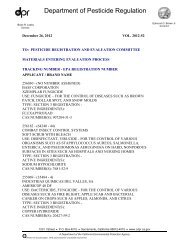Dichlorvos (DDVP) Risk Characterization Document - California ...
Dichlorvos (DDVP) Risk Characterization Document - California ...
Dichlorvos (DDVP) Risk Characterization Document - California ...
Create successful ePaper yourself
Turn your PDF publications into a flip-book with our unique Google optimized e-Paper software.
Oncogenic risk was determined based on the finding of mononuclear leukemia in rats given <strong>DDVP</strong> by<br />
gavage for 2 years. The human equivalent potency factors were 0.20 mg/kg-day -1 for q 1 and 0.35<br />
mg/kg-day -1 for q 1 *, the 95th percentile upper confidence limit.<br />
Exposure Assessment- The potential health hazard associated with the use of <strong>DDVP</strong> was<br />
considered for occupational, residential, and dietary exposures under acute, chronic, and lifetime<br />
scenarios. The population subgroups exposed to <strong>DDVP</strong> in the work place were workers involved in<br />
warehouse fumigation, livestock applications, and structural applications. Residential exposures to<br />
<strong>DDVP</strong> were due to the use of liquid sprays, foggers, no-pest strips, and flea collars. Dietary<br />
exposures to <strong>DDVP</strong> were due to the use on raw agricultural commodities (RAC), livestock, and<br />
processed foods. Estimates for chronic dietary exposure by USEPA were also assessed.<br />
RISK APPRAISAL<br />
The margins of safety (MOSs) for non-oncogenic effects from acute, chronic, and lifetime occupational<br />
exposures were less than 100 for the workers involved in warehouse fumigation, livestock<br />
applications, and structural applications. The lifetime oncogenic risk for the workers was greater than<br />
1 x 10 -6 .<br />
For residential exposure, the MOSs for non-oncogenic effects were greater than 100 only for<br />
structural residents (chronic and lifetime), and pet owners (acute, chronic, and lifetime). The MOSs<br />
were less than 100 for all other home uses under acute, chronic, and lifetime exposures. The lifetime<br />
oncogenic risk for the residents under all exposure scenarios was greater than 1 x 10 -6<br />
For dietary exposure assessment using either USEPA or DPR exposure estimates, the MOSs for nononcogenic<br />
effects were at or greater than 100 for all population subgroups for acute and chronic<br />
exposure. For lifetime exposure to all commodities, the oncogenic risk for the U.S. population was<br />
greater than 1 x 10 -6 for both DPR and USEPA estimates.<br />
For combined exposures in the work place and at home, the MOSs for non-oncogenic effects for all<br />
the workers were less than 100 and the lifetime oncogenic risk was greater than 1 x 10 -6 .<br />
TOLERANCE ASSESSMENT<br />
The MOSs for the acute exposure based on individual tolerances on RACs and livestock products<br />
were greater than 100.<br />
CONCLUSIONS<br />
The toxicological risk of potential exposure to <strong>DDVP</strong> was evaluated for occupational, residential,<br />
dietary and combined uses based on the inhibition of brain ChE activity, clinical signs, and the finding<br />
of mononuclear leukemia in animal studies. Using the conventional benchmark levels, a margin of<br />
safety of at least 100 for non-oncogenic effects and a risk level of 1 x 10 -6 or less for oncogenic effects<br />
are generally considered sufficiently protective of human health. The exposure levels of only a few<br />
groups meet those benchmark levels. Groups which have exposure levels which do not meet the<br />
benchmark levels are: all people occupationally exposed to <strong>DDVP</strong> alone and in combination with<br />
home exposure on an acute, chronic, and lifetime basis; people exposed through residential use on<br />
an acute, chronic, and lifetime basis; and the general population exposed through the diet on a<br />
potentially lifetime basis.<br />
3
















